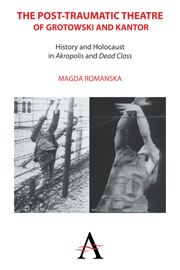 The Post-traumatic Theatre of Grotowski and Kantor
The Post-traumatic Theatre of Grotowski and Kantor from Part I - Our Auschwitz: Grotowski's Akropolis
In “Essay on Cultural Criticism and Society” (1949), Theodore Adorno puts forth a dramatic thesis: “to write a poem after Auschwitz is barbaric.” Adorno's statement implies that the experience of Auschwitz altered our relationship to language. In a way, Adorno argues, the Holocaust leaves us speechless. Following Adorno, artists, writers, poets, painters and filmmakers, as well as literary critics, have struggled with the issue of representation: how, if at all, should the Holocaust be represented? What does representing it mean if every representation is connected to the European project of Enlightenment, the very idea of humanism, its failure and aftermath? Among other things, the Holocaust reduced death from a unique experience that defines our humanity to mass production. Jean Amery, for example, argues that Auschwitz altered the European aesthetic of death and dying. After the Holocaust, death could no longer be seen through the prism of art:
The first result was always the total collapse of the esthetic view of death. What I am saying is familiar. The intellectual, and especially the intellectual of German education and culture, bears this esthetic view of death within him. It was his legacy from the distant past, at the very latest from the time of German romanticism. It can be more or less characterized by the names Novalis, Schopenhauer, Wagner, and Thomas Mann. For death in its literary, philosophic, or musical form there was no place in Auschwitz. No bridge led from death in Auschwitz to Death in Venice. Every poetic evocation of death became intolerable, whether it was Hesse’s Dear Brother Death or that of Rilke, who sang: “Oh Lord, give each his own death.” The esthetic view of death had revealed itself to the intellectual as part of an esthetic mode of life; where the latter had been all but forgotten, the former was nothing but an elegant trifle.
To save this book to your Kindle, first ensure no-reply@cambridge.org is added to your Approved Personal Document E-mail List under your Personal Document Settings on the Manage Your Content and Devices page of your Amazon account. Then enter the ‘name’ part of your Kindle email address below. Find out more about saving to your Kindle.
Note you can select to save to either the @free.kindle.com or @kindle.com variations. ‘@free.kindle.com’ emails are free but can only be saved to your device when it is connected to wi-fi. ‘@kindle.com’ emails can be delivered even when you are not connected to wi-fi, but note that service fees apply.
Find out more about the Kindle Personal Document Service.
To save content items to your account, please confirm that you agree to abide by our usage policies. If this is the first time you use this feature, you will be asked to authorise Cambridge Core to connect with your account. Find out more about saving content to Dropbox.
To save content items to your account, please confirm that you agree to abide by our usage policies. If this is the first time you use this feature, you will be asked to authorise Cambridge Core to connect with your account. Find out more about saving content to Google Drive.